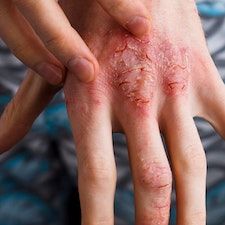Article
Alopecia Areata, Atopic Dermatitis Successfully Treated by Switching to Baricitinib
Author(s):
A recent research letter highlighted a case observed in Japan in which a patient with alopecia totalis, and an associated case of atopic dermatitis, was treated effectively with baricitinib, a JAK inhibitor.

In a recent research letter, a case was described in which a patient with alopecia areata (AA) was suffering from the common complication of atopic dermatitis (AD) and was then effectively treated after switching from dupilumab to baricitinib.
The team writing the letter, led by Kentaro Izumi, MD, PhD, from the Hokkaido University Hospital Department of Dermatology, explored the case due to the fact that AD-associated AA being successfully treated by switching to baricitinib had never been reported.
“A 62-year-old man visited our department with a six-year history of multiple patches of hair loss,” Izumi and colleagues wrote. “He had a history of AD since childhood. The AA had progressed rapidly and eventually presented as alopecia totalis.”
“He had been treated for AA initially with topical psoralen plus ultraviolet A photochemotherapy and oral prednisolone for six months, without significant hair regrowth.”
The investigators noted that the patient had been referred to their department at Hokkaido University Hospital due to his AD being ineffectively controlled with topical corticosteroid therapy. He had been able to achieve temporary hair regrowth with topical squaric acid dibutyl ester (SADBE) but his hair loss had recurred.
The patient was shown to have had total hair loss on several regions, including both his scalp and eyebrows, in addition to erythema and lichenification around his entire face and body. Some of his information included:
- Affected Body Surface Area (BSA) of 60%
- Patient-Oriented Eczema Measure (POEM) score of 9.0
- Eczema Area and Severity Index (EASI) score of 25.9
- Severity of Alopecia Tool (SALT) II score of 100
The team initiated dupilumab for the patient’s AD along with topical corticosteroids. Both were reported to have been helpful for the eczematous lesions, with the patient’s month 14 follow-up demonstrating an EASI score of 0.6, affected BSA of 3%, and POEM score of 0. The combined use of dupilumab and SADBE treatment was found not to have improved the AA.
The patient was later switched to baricitinib treatment following over a year of dupilumab therapy. SADBE was also discontinued as a result of its ineffectiveness against his AA symptoms.
“His eyebrows, mustache, beard, both sides of the head, and occiput showed hair regrowth three months after the start of baricitinib.”
“To the best of our knowledge, AD-associated AA successfully treated by switching from dupilumab to baricitinib has never been reported,” they explained. “It has been considered that a Th1 immune response contributes to the AA pathogenesis; however, the contribution of Th2 inflammation has been proposed recently. Dupilumab downregulates Th2 inflammation by blocking IL-4 signaling, and it is expected to have therapeutic benefits for AA.”
The research letter highlighted the fact that the case further supports the efficacy of baricitinib. The case could indicate the usefulness of baricitinib as an option for treatment with cases of AD-associated AA that have been resistant to dupilumab.
This letter, titled "A case of atopic dermatitis-associated dupilumab-resistant alopecia totalis successfully treated with baricitinib," was published online on Dermatologic Therapy.





